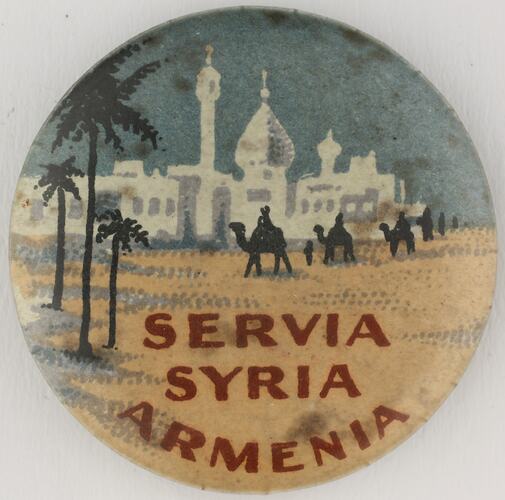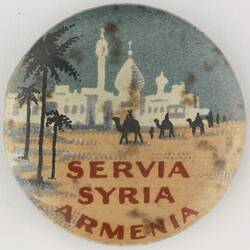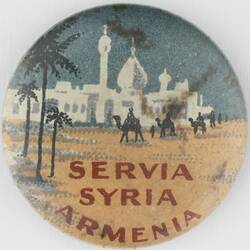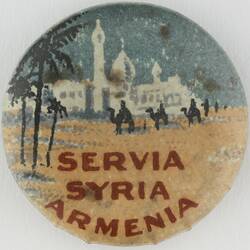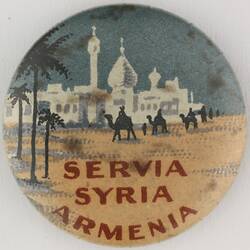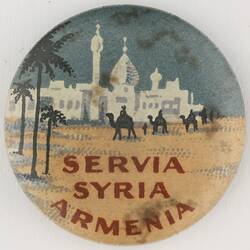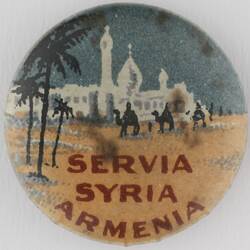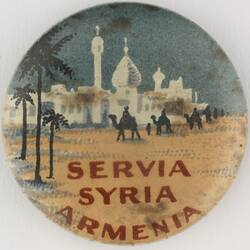Summary
Alternative Name(s): Pin, Button
'Servia Syria Armenia' Suffering Nations Button Day fundraising badge, made in 1917 to raise funds for displaced people in Serbia, Syria and Armenia following approval from the State War Council. The appeal was supported by State and Federal governments and churches, and was coordinated through the Commonwealth Button Fund. Mrs Frances Woolcott, Honorary Organiser of the Melbourne branch of the Commonwealth Button Fund, managed the badge's design. Four types were issued: two circular badges of tin, paper and celluloid, sold for and 1/- or 2/6 depending on size; and two brooch-style badges of enamelled brass or sterling silver.
The Suffering Nations' Button day was held on Friday 7 December 1917. Plans for the day were described in the Leader newspaper, Melbourne:
'ANOTHER BUTTON DAY. The last button day of the present year is to be held on Friday, 7th December. It is to be called "The Suffering Nations' Button day," and its purpose is to provide assistance for the Servians, Syrians and Armenians, who have suffered the most frightful ravages of war and cruel hardships. There will be the usual street kiosks for the sale of goods, some of which will be specially devoted to the sale of Christmas stockings. An appropriate design has been selected for the button of the day. It depicts camels crossing the desert, with typical Eastern buildings in the distance. The buttons will be sold, as usual at 1/ each for the smaller size, and 2/6 each for the larger size. Special buttons will be sold at 10/6 and £1, the latter being of sterling silver. Mrs. A. S. Woolcott, honorary organiser of the Button Fund, who has all preparations well in hand, will be pleased to receive donations either in the nature of cash or of goods to be sold at the kiosks. Such donations may be sent to the offices of the Commonwealth Button Fund, 39 Collins street.' (24 Nov 1917, p.32)
It was calculated that over £7,300 was raised nationally during the Suffering Nations Button Day appeal.
During and after World War I, large numbers of badges were made to raise funds for particular causes, including comforts and medical aid for those serving overseas; assisting widows and children of deceased soldiers; assisting with the purchase of aids and treatment for soldiers who returned with disabilities; and assisting particular nations or groups of people. Badges were worn or displayed on ribbons or other fabric items, signifying involvement in the war effort and expressing patriotism.
Physical Description
Round metal badge in orange, blue, black and white. Desert scene with city, three palm trees and camels with riders silhouetted. Words printed under scene. Pin at back fits into slot.
More Information
-
Collecting Areas
-
Acquisition Information
Donation from Mr H. Legge, 14 Feb 1989
-
Date Issued
-
Place Named
-
Place Named
-
Place Named
-
Inscriptions
Under desert scene: "SERVIA / SYRIA / ARMENIA" Outer lower rim: "COPYRIGHT".
-
Classification
-
Category
-
Discipline
-
Type of item
-
overall dimensions
5 mm (Height), 33 mm (Outside Diameter)
-
References
'Suffering Nations Button Day fundraising badge: Serbia, Syria, Armenia', Australian War Memorial, [Link 1] accessed 15/12/2021. 1917 'ANOTHER BUTTON DAY.', Leader (Melbourne, Vic. : 1862 - 1918, 1935), 24 November, p. 42. (TOWN and WEEKLY), viewed 15 Dec 2021, [Link 2] 1917 'BUTTON DAY.', The Argus (Melbourne, Vic. : 1848 - 1957), 28 November, p. 11. , viewed 15 Dec 2021, [Link 3] 191 "Suffering Nations" Button Day. 'GENERAL NEWS.', The Age (Melbourne, Vic. : 1854 - 1954), 28 November, p. 11. , viewed 15 Dec 2021, [Link 4] Nick Pezikian, 2016. 'Armenian Relief Fundraising Badges'.
-
Keywords
